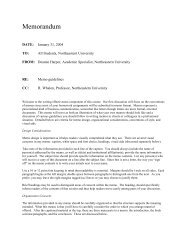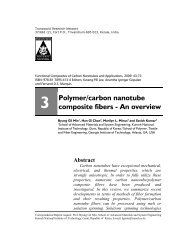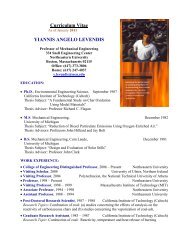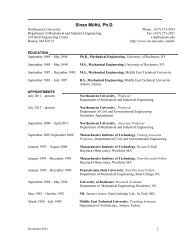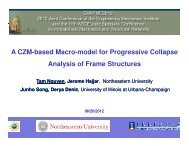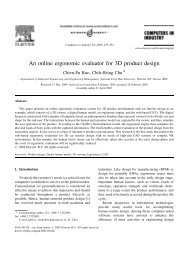Create successful ePaper yourself
Turn your PDF publications into a flip-book with our unique Google optimized e-Paper software.
Table 8<br />
Summary of test failure for several hef /d ratios.<br />
All tests<br />
L. Pallarés, J.F. <strong>Hajjar</strong> / Journal of Constructional Steel Research 66 (2010) 198–212 209<br />
# tests S.F. a<br />
C.F. b<br />
M.F. c<br />
Comments<br />
hef /d ≥ 4.00 251 184 51 16 73.33% failed in the steel<br />
hef /d < 4.00 140 18 63 54 87.14% failed in the concrete or mixed failure<br />
hef /d ≥ 4.50 224 182 29 13 81.25% failed in the steel<br />
hef /d < 4.50 167 20 85 62 88.02% failed in the concrete or mixed failure<br />
hef /d ≥ 5.50 69 63 6 0 91.30% failed in the steel<br />
hef /d < 5.50 322 139 108 75 56.83% failed in the concrete or mixed failure<br />
hef /d ≥ 6.50 43 42 1 0 97.67% failed in the steel<br />
hef /d < 6.50 348 160 113 75 54.02% failed in the concrete or mixed failure<br />
Normal-weight concrete<br />
hef /d ≥ 4.00 201 164 28 13 81.59% failed in the steel<br />
hef /d < 4.00 75 9 41 20 81.33% failed in the concrete or mixed failure<br />
hef /d ≥ 4.50 187 158 16 13 84.49% failed in the steel<br />
hef /d < 4.50 99 11 53 35 88.89% failed in the concrete or mixed failure<br />
hef /d ≥ 5.50 50 49 1 0 98.00% failed in the steel<br />
hef /d < 5.50 236 120 68 48 49.15% failed in the concrete or mixed failure<br />
hef /d ≥ 6.50 33 32 1 0 96.96% failed in the steel<br />
hef /d < 6.50 253 137 68 48 45.84% failed in the concrete or mixed failure<br />
Lightweight concrete<br />
hef /d ≥ 4.00 50 24 23 3 60.00% failed in the steel<br />
hef /d < 4.00 65 9 22 34 83.63% failed in the concrete or mixed failure<br />
hef /d ≥ 4.50 37 24 13 0 64.86% failed in the steel<br />
hef /d < 4.50 68 9 32 27 86.76% failed in the concrete or mixed failure<br />
hef /d ≥ 5.50 19 14 5 0 73.68% failed in the steel<br />
hef /d < 5.50 86 19 40 27 77.90% failed in the concrete or mixed failure<br />
hef /d ≥ 6.50 10 10 0 0 100% failed in the steel<br />
hef /d < 6.50 95 23 45 27 75.78% failed in the concrete or mixed failure<br />
a S.F.: Steel failure (weld failures are included as steel failures).<br />
b C.F.: Concrete failure.<br />
c M.F.: Mixed failure or not reported.<br />
Table 9<br />
Resistance factors for tests with hef /d ratios larger than 4.5 <strong>and</strong> 4.0.<br />
224 tests, hef /d > 4.5 φ 251 tests, hef /d > 4.0 φ<br />
Cv µ σ C.O.V. β = 3 β = 4 Cv µ σ C.O.V. β = 3 β = 4<br />
Option 1 1.00 0.910 0.158 0.174 0.65 0.58 1.00 0.890 0.172 0.193 0.62 0.55<br />
Option 2 0.75 1.213 0.211 0.174 0.87 0.77 0.75 1.186 0.229 0.193 0.83 0.73<br />
Option 3 0.65 1.399 0.244 0.174 – 0.90 0.65 1.369 0.264 0.193 0.95 0.85<br />
for normal-weight concrete 65% of the tests have hef /d > 4.5,<br />
thus providing a much larger sample size (see the portions of<br />
Table 8 that disaggregate the test data for different weights of<br />
concrete). Thus, it may be deemed less conclusive what value of<br />
hef /d is required to ensure that just checking a steel failure formula<br />
is adequate for lightweight concrete. The results of Fig. 5 imply<br />
that the steel strength formula adequately predicts both normalweight<br />
<strong>and</strong> lightweight concrete failures, but Table 8 shows that a<br />
relatively large percentage of failures are occurring in the concrete<br />
if a minimum value of hef /d is taken as 4.5. From Table 8, a value of<br />
6.5 for hef /d (i.e., or a value of h/d > 7) more clearly assures failure<br />
in the steel for lightweight concrete, <strong>and</strong> thus this is proposed as<br />
the minimum hef /d for lightweight concrete if only the steel failure<br />
mode is to be checked. However, it is noted that there are fewer<br />
tests results to validate this conclusion as compared to normalweight<br />
concrete. Alternatively, for composite components that use<br />
lightweight concrete, either Proposal 4 of Table 7 should also be<br />
checked, or the provisions of ACI 318-08 Appendix D or similar<br />
should be used in total.<br />
8. Seismic behavior of steel anchors in shear<br />
Results from the literature generally show that push-out specimens<br />
having headed steel stud anchors subjected to cyclic shear<br />
force exhibited lower strength <strong>and</strong> ductility than corresponding<br />
monotonic push specimens. A number of experiments on headed<br />
steel anchors subjected to cyclic loading have been conducted to<br />
study the behavior of steel frames with reinforced concrete infills.<br />
For example, Makino [58] conducted experiments were performed<br />
on single-story, single-bay steel frames with reinforced concrete<br />
infills at approximately a one-third scale. They estimated that the<br />
cyclic strength of the studs was approximately 50% of the predicted<br />
strength from the formulas of Ollgaard et al. [15]. Civjan<br />
<strong>and</strong> Singh [38] conducted seven cyclic tests <strong>and</strong> concluded that<br />
reversed cyclic loading resulted in nearly a 40% reduction in the<br />
stud shear strength compared to monotonic strengths computed<br />
by AISC 2005, attributing this reduction to low-cycle fatigue of<br />
the stud <strong>and</strong> weld materials as well as concrete degradation. Gattesco<br />
<strong>and</strong> Giuriani [35] tested two specimens under cyclic loading<br />
<strong>and</strong> concluded that the accumulated damage during cycles reduced<br />
the measured monotonic strength by almost 10%. Saari et al. [39]<br />
carried out eight tests under different combinations of shear <strong>and</strong><br />
tension loads <strong>and</strong> both monotonic <strong>and</strong> cyclic loads with different<br />
amounts of confining reinforcement around the anchors within<br />
a specimen modeling an infill wall. From their tests they determined<br />
that when good detailing is provided surrounding the studs<br />
in the specimen, the cyclic failure always occurred in the steel. Also,<br />
under shear forces, a 21% reduction in measured monotonic stud<br />
shear strength was found.<br />
These reduction factors for cyclic loading (ξ) for conditions representing<br />
either infill wall specimens or composite slabs without



